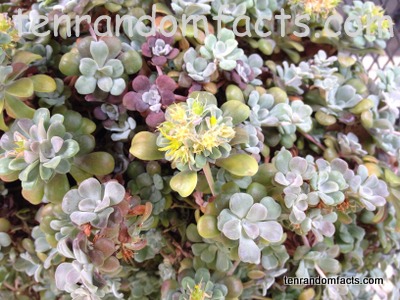Broadleaf stonecrops certainly hide stones when growing among them.
- A broadleaf stonecrop is a variety of a small, perennial and evergreen plant, and is classified as a succulent.
- Broadleaf stonecrops are native to the rocky sections of mountainous regions in western parts of North America.
- The scientific name of a broadleaf stonecrop is Sedum spathulifolium and it is from the family Crassulaceae, the family of stonecrops.
- ‘Broadleaf stonecrops’ are also known as ‘Pacific stonecrops’, ‘Purdy’s stonecrops’, ‘Yosemite stonecrops’, ‘spoon-leaved stonecrops’, and ‘blood leaf sedums’.
- A variety of broadleaf stonecrop, the Cape Blanco, has received the Award of Garden Merit from the United Kingdom’s Royal Horticultural Society for its decorative nature, while the species in general is commonly grown as a ground cover.
- The leaves of broadleaf stonecrop plants are thick, powdery or waxy on touch, and range from green, to pink and red in colour, and they are roughly 1 to 2 centimetres (0.4 to 0.8 inches) in length.
- The small broadleaf stonecrop flowers are star-like in shape, and are of a yellow colour, and they bloom throughout the summer months.
- Broadleaf stonecrop plants grow roughly 10 to 15 centimetres (4 to 6 inches) in height, and they spread up to 50 cm (20 inches) in diameter.
- A wide variety of soils can be used to grow broadleaf stonecrops, and the plant thrives best in full sun and is drought tolerant.
- The leaves of broadleaf stonecrops can be eaten both cooked and raw in small quantities, best picked before the plant blooms, while the plant has been used for a number of medicinal purposes.
Bibliography:
Pacific Stonecrop, Broadleaf Stonecrop ‘Cape Blanco’, 2015, Dave’s Garden, http://davesgarden.com/guides/pf/go/37066/#b
Sedum spathulifolium – Hook., Plant For A Future, http://www.pfaf.org/user/plant.aspx?latinname=Sedum+spathulifolium
Sedum Spathulifolium ‘Cape Blanco’, 2015, Perennials.com, http://www.perennials.com/plants/sedum-spathulifolium-cape-blanco.html
Sedum Spathulifolium, 2015, Wikipedia, https://en.wikipedia.org/wiki/Sedum_spathulifolium






